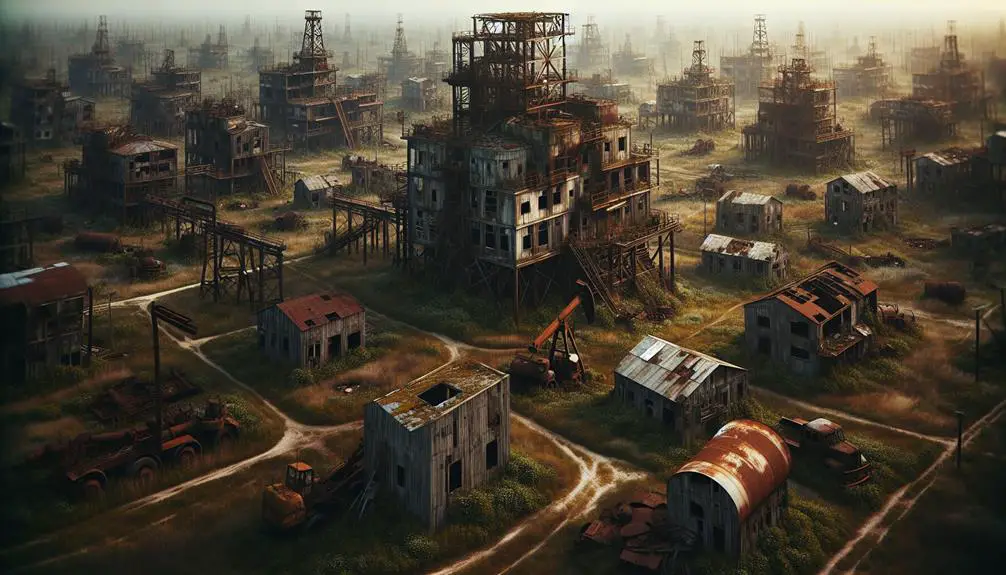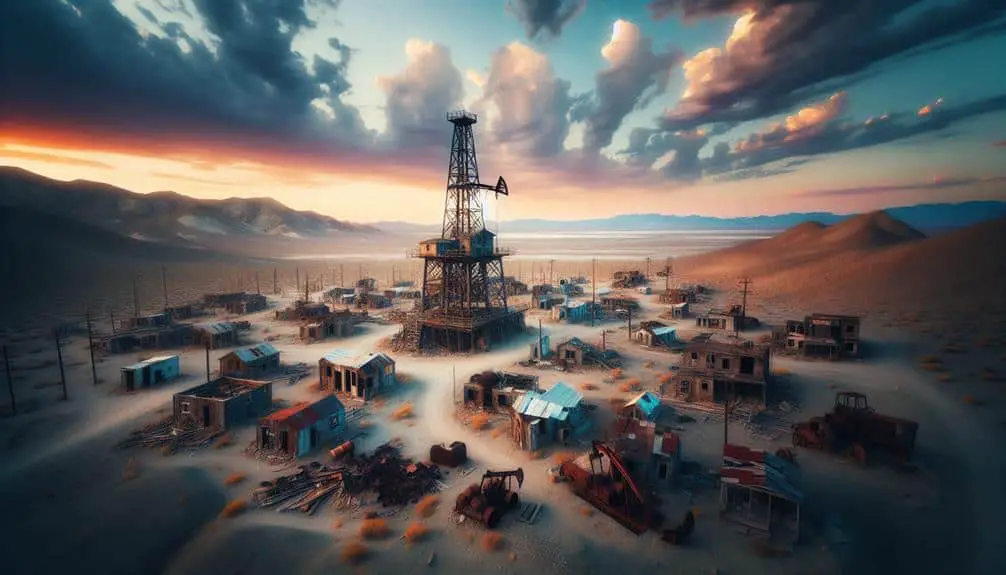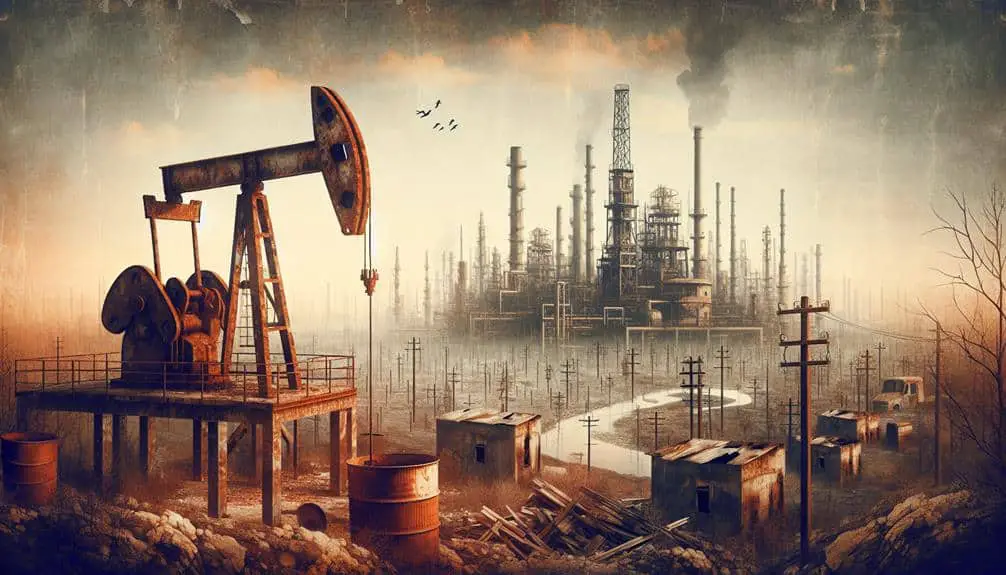Preserving deserted oil rig town remains demands specialized techniques. Maintain structural integrity for longevity and safety. Inspect regularly for signs of corrosion. Consider environmental impact while preserving. Use eco-friendly materials to reduce carbon footprint. Document the history to reveal significance and evolution. Learn from past functions, advancements, and impact. Engage the community for long-term protection. Volunteers are essential for maintaining and restoring. Encourage clean-up and restoration activities for ownership. Form partnerships for resources and expertise. Local involvement deepens understanding and appreciation. Guarantee meticulous care to safeguard historical legacy. A deeper exploration awaits to uncover more preservation tips for these unique sites.
Key Points
- Conduct regular inspections to assess structural integrity and identify maintenance needs.
- Utilize environmentally friendly preservation techniques to minimize ecological impact.
- Engage the local community for volunteer support in cleanup and restoration efforts.
- Document historical records to understand the evolution and significance of the town remains.
- Establish partnerships with local organizations for resources and expertise in preservation projects.
Conservation Techniques for Oil Rig Structures
To effectively preserve oil rig structures, it's imperative to employ specialized conservation techniques that prioritize long-term sustainability and protection against environmental degradation. Maintaining the structural integrity of these structures is essential to guarantee their longevity and safety. Regular inspections should be conducted to identify any signs of corrosion or wear that could compromise the stability of the rig.
In addition to structural concerns, the environmental impact of preserving oil rig structures must also be carefully considered. Any conservation efforts should aim to minimize disruption to the surrounding ecosystem and marine life. Using environmentally friendly materials and techniques can help reduce the carbon footprint of the preservation process.
Importance of Historical Documentation
Historical documentation plays a pivotal role in understanding the evolution and significance of oil rig structures. It sheds light on their past functions, technological advancements, and environmental impact. By delving into the historical significance of these structures, you can uncover the stories of the individuals who lived and worked in these oil rig towns, providing valuable insights into their way of life and the challenges they faced. Archival resources such as old photographs, maps, engineering blueprints, and personal accounts offer a window into the past, allowing you to piece together the narrative of these deserted oil rig towns.
Through historical documentation, you can trace the development of oil extraction technologies, the economic booms and busts that shaped these communities, and the environmental changes brought about by industrial activities. Preserving these records guarantees that future generations can learn from the mistakes and successes of the past, fostering a deeper appreciation for the heritage of these oil rig structures and the lessons they hold for sustainable development.
Community Involvement for Preservation
Engaging the local community in the preservation efforts of deserted oil rig towns is essential for guaranteeing the long-term protection and conservation of these historical sites. Volunteer engagement plays a pivotal role in maintaining and restoring these unique locations. Encouraging community members to participate in clean-up days, restoration projects, and guided tours fosters a sense of ownership and pride in these abandoned settlements.
Establishing local partnerships is another key aspect of community involvement for preservation. Collaborating with nearby businesses, schools, and organizations can provide valuable resources, funding, and expertise to support the conservation efforts. By working together, the community can pool their skills and resources to tackle challenges such as infrastructure maintenance, historical research, and educational programming.
Involving the community in the preservation of deserted oil rig towns not only guarantees the physical upkeep of these sites but also promotes a deeper understanding and appreciation of their historical significance. Through volunteer engagement and local partnerships, these unique remnants of the past can be safeguarded for future generations to explore and learn from.
Frequently Asked Questions
What Are the Potential Environmental Impacts of Preserving Deserted Oil Rig Town Remains?
Preserving deserted oil rig town remains can have significant environmental impacts. Using proper preservation techniques is vital to minimize harm. Consideration of wildlife habitats, water quality, and long-term sustainability is essential.
How Can Technology Be Utilized to Help Preserve and Document These Structures?
To preserve and document deserted oil rig town remains, utilize technology for virtual tours and 3D modeling. Drones capture aerial views, while augmented reality provides immersive experiences, ensuring these structures are digitally mapped and accessible for future generations to explore.
Are There Any Legal Challenges or Regulations That Need to Be Considered When Preserving Deserted Oil Rig Town Remains?
When preserving deserted oil rig town remains, legal challenges and regulatory considerations must be addressed. Research zoning laws, environmental impact regulations, and historic preservation mandates. Adherence guarantees the protection and sustainability of these unique structures.
How Can Tourists and Visitors Respectfully Interact With These Preserved Sites?
When exploring historic sites like deserted oil rig towns, remember to tread lightly, respect the past, and appreciate the historical significance. Take only pictures, leave only footprints, and honor the stories these preserved sites hold.
What Long-Term Maintenance and Funding Plans Are in Place to Ensure the Continued Preservation of These Structures?
To guarantee the continued preservation of these structures, funding sustainability and structural maintenance plans are essential. Your dedication to long-term support will safeguard these historic sites for future generations to appreciate and learn from.



